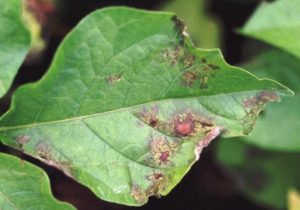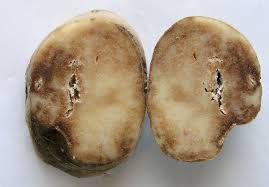

Blight is a plant disease, especially one that is caused by fungi such as mildews, rusts, and smuts. It is a rapid and complete chlorosis, browning and then death of plant tissues, such as leaves, branches, twigs, or floral organs. On leaf tissue, symptoms of blight are the initial appearance of lesions which rapidly engulf surrounding tissue. However, leaf spots, may, in advanced stages, expand to kill entire areas of leaf tissue and thus exhibit blight symptoms. The highlands of central Mexico are considered by many to be the center of origin of the disease, although others have proposed its origin to be in the Andes, which is also the origin of potatoes. The color of potato sign is white. People can observe blight produce sporangia and sporangiophores on the surface of potato stems and leaves. Under ideal conditions, the life cycle can be completed on potato or tomato foliage in about five days. Sporangia develop on the leaves, spreading through the crop when temperatures are above 10 °C and humidity is over 75–80% for 2 days or more. This disease in the potatoes caused massive amounts of deaths during the 19th century in Ireland. People were getting sick while eating these infected potatoes, but the majority of people dies from starvation because the potato crop was in such abundance before the blight outbreak, and Irish people were so dependent on the crop. When taken away from them they had nothing else to turn to.
Because of the potato flight in the 19th century many Irish people suffered from the Irish potato famine. CLICK HERE to learn all about the Irish potato famine that was caused by the blight disease!
CLICK HERE to go back to the main page
